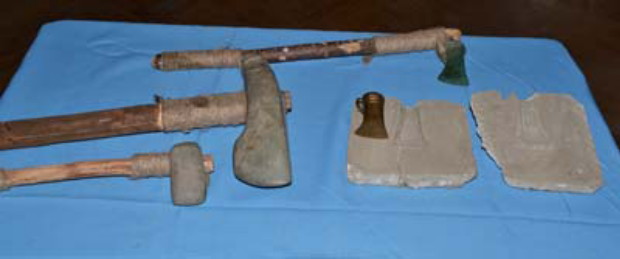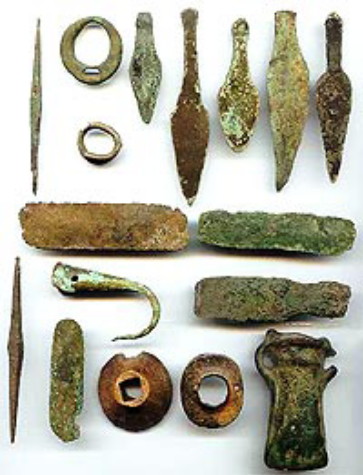Bronze Age
Bronze Age [Бронзовий вік; Bronzovyi vik]. Historical-cultural period in which bronze utensils, implements, and weapons began to be manufactured. Bronze implements became increasingly widespread alongside stone implements. Owing to the greater hardness of bronze, an alloy of copper and tin, as compared to copper, bronze culture replaced the Copper Age or Eneolithic Period and lasted from the end of the 4th millennium to the 1st millennium BC. The bronze culture did not develop synchronously: the territories that were remote from the advanced centers of civilization retained their Neolithic form of life based on hunting and fishing. There the transition to metal progressed slowly. In Europe bronze products were known in the 3rd–2nd millennium BC. Deposits of copper and tin ores were located at the time in Spain, England, France, Austria, and Hungary. Caucasia played an important role in this age by supplying the steppe regions of eastern Europe with bronze implements at the end of the 2nd millennium BC.
Barter trade was gradually established and developed in the regions of metal mining. On Ukrainian territory trade stimulated the rapid development of livestock grazing and primitive agriculture and facilitated the transition to a patriarchal clan system and the economic stratification of the livestock-herding tribes. The tribes who lived west of the Dnipro River and north of the Dnister River usually obtained their bronze from Subcarpathia; the tribes east of the Dnipro River obtained their bronze from Caucasia and partly from the Donets Basin.
The Bronze Age on Ukrainian territory and in all eastern Europe can be divided into three periods: (1) the early period from the 19th to the 17th century BC; (2) the middle period from the 16th to the 14th century BC; and (3) the late period, from the 13th to the 9th century BC. The oldest Neolithic-Bronze Age culture in central and western Ukraine was the Trypillia culture. The oldest Copper Age-Bronze Age culture that existed on Ukrainian territories between the Dnipro River and the Volga River was the Yamna archeological culture complex of the livestock-grazing and agricultural tribes who lived east and partly west of the Dnipro River. Later, during the early Bronze Age, the southern steppe region of Ukraine east of the Dnipro River was inhabited by livestock-raising tribes of the Catacomb culture, who also occupied the Don region and the Caspian steppes. These tribes maintained close trade relations with the tribes of northwestern Caucasia. In the early 2nd millennium BC seminomadic livestock-raising tribes of the Corded-Pottery culture appeared from the west in Right-Bank Ukraine. Migrating eastwards, they mingled with the indigenous tribes and thus gave rise to the Middle-Dnipro culture.
In the middle Bronze Age almost all the forest-steppe of the Dnipro River and Dnister River regions was settled by tribes of the Trzciniec culture (see also Komariv culture), whose artifacts are found also in Poland. In the east the basins of the Desna River and Seim River were inhabited by the tribes of the Marianivka culture and Bondarykha culture. In southern and southwestern Ukraine the so-called Multicylindrical-Pottery culture flourished at that time.
In the late Bronze Age the tribes of the Bilohrudivka culture inhabited the forest-steppe west of the Dnipro River. East of the Dnipro River the late Marianivka culture and Bondarykha culture continued to flourish. In the middle Dnister River region the Noua culture was widespread. Its agricultural and livestock-raising tribes were advanced in their bronze casting and maintained ties with the Transylvanian centers of metallurgy. They were also in contact with the tribes of central Europe and western Ukraine. Their bronze artifacts also reached the tribes of the late Timber-Grave culture.
In Transcarpathia the Stanove culture of agricultural and cattle-raising tribes was advanced in bronze casting and was connected with the Transylvanian centers. Many valuable bronze artifacts—weapons, farm implements, decorative objects, and horse armor—have been found in the region. A large proportion of these articles come from the Tysa River–Danube River Basin.
The tribes of the Timber-Grave culture, who were related to the Scythians, moved into the Black Sea steppes in the middle of the 2nd millennium and lived there until the 8th century BC. They lived by agriculture and animal husbandry and partly by bronze manufacturing. Bronze smithies and foundries of this culture, with molds of daggers, spearheads, decorative objects, and farm implements, have been uncovered. A shortage of metals forced these tribes to establish close cultural ties with the Noua culture tribes, who provided them with metal ores from the Transylvanian centers.
During the Bronze Age important historical developments, migrations, and military encounters took place in southern Ukraine. Ukraine became the location of various tribal cultures and alliances. Some tribes were gradually assimilated by others and disappeared. Others continued to exist in the Iron Age.
BIBLIOGRAPHY
Shovkoplias, I. Arkheolohichni doslidzhennia na Ukraïni, 1917–1957 (Kyiv 1957)
Artemenko, I. Plemena Verkhnego i Srednego Podneprov’ia v epokhu bronzy (Moscow 1967)
Sulimirski, T. Prehistoric Russia (London 1970)
Arkheolohiia Ukraïns’koï RSR (Kyiv 1971)
Berezanskaia, S. Srednii period bronzovogo veka v Severnoi Ukraine (Kyiv 1972)
Svieshnikov, I. Istoriia naselennia Peredkarpattia, Podillia i Volyni v kintsi III–na pochatku II tysiacholittia do nashoï ery (Kyiv 1974)
Eneolit i bronzovyi vek Ukrainy (Kyiv 1976)
Neonila Kordysh-Holovko
[This article originally appeared in the Encyclopedia of Ukraine, vol. 1 (1984).]

.jpg)

